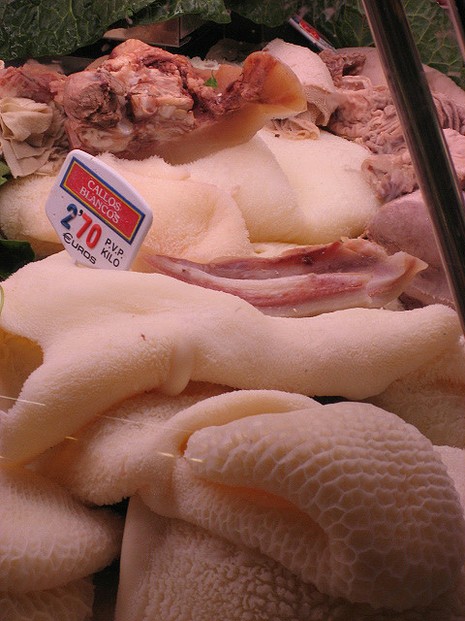Cows have four chambers in their stomach. The first is the rumen, the second the reticulum, the third the omasum, and the fourth the abomasum. The first stomach chamber is the "blanket" tripe, the second the "honeycomb" tripe and third is the "bible" or "book" tripe. The last chamber is rarely used because of its texture.
Honeycomb tripe is the most preferred for cooking.
Tripe has a gamey odor, which depends on what animal it comes from and what the animal last ate. The other ingredients cooked with tripe usually mask the odor.
Tripe is usually sold bleached and often is partially cooked. Unprocessed tripe needs to be cooked as long as 12 hours to make it tender enough to chew.


 In order for tripe to be edible, it must be thoroughly cleaned. When you bring tripe home, you must rinse it thoroughly until the water runs clear and there is no grittiness.
In order for tripe to be edible, it must be thoroughly cleaned. When you bring tripe home, you must rinse it thoroughly until the water runs clear and there is no grittiness.




 Menudo is a traditional spicy Mexican soup made with tripe. Many people believe menudo can cure a hangover.
Menudo is a traditional spicy Mexican soup made with tripe. Many people believe menudo can cure a hangover.




 I Loved to Read in Grade School (in the 1960s)on 09/29/2018
I Loved to Read in Grade School (in the 1960s)on 09/29/2018
 Halloween Memories from the 1960son 09/17/2018
Halloween Memories from the 1960son 09/17/2018
 What on Earth is Earthing?on 06/03/2015
What on Earth is Earthing?on 06/03/2015
 Worm Manure (Castings) Is The Best Organic Fertilizeron 05/25/2015
Worm Manure (Castings) Is The Best Organic Fertilizeron 05/25/2015



Do You Want to Try Tripe?
I'll pass. I'm sure it's an acquired taste, but for now I'll stick with the more traditional parts of the cow. Interesting article and recipe, though!
Yes Angela, she sliced it and it looked like pinwheels. She called it brasciole, although the more modern version of brasciole is made with flank steak.
candy47 - I haven't seen a recipe like yours, either. After the tripe was cooked rolled up, did your grandmother slice it like a thin loaf of bread?
Candy, your recipe is news to me, I had never heard of this way of cooking tripe, and it seems to be a way in which tripe can be used.
Being of Italian descent, tripe was practically a food staple. My grandmother would lay it flat then spread ricotta cheese and spinach on it along with herbs, spices and parmesan. Roll it up, tie it with string and let it simmer for hours.
It's not as bad as it sounds, and it tastes a little like squid.
burntchestnut, It's interesting that tripe appears in cuisines worldwide. For me, tripe will always remain a vicarious experience, with no basis in reality.
I tried it once, but I could not swallow it.